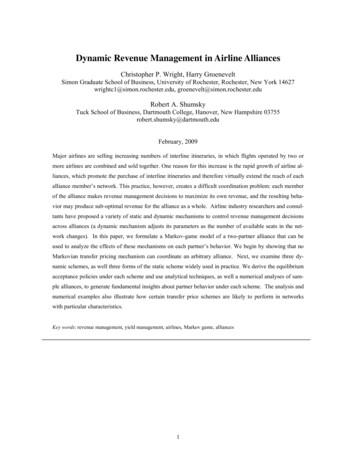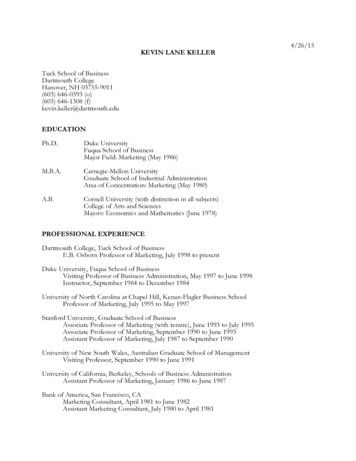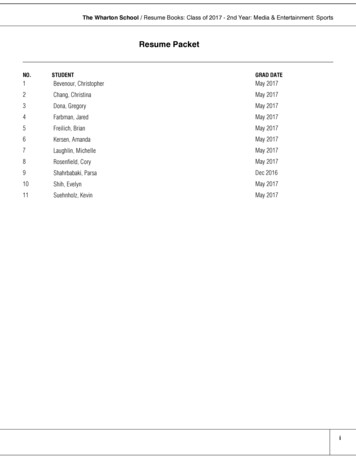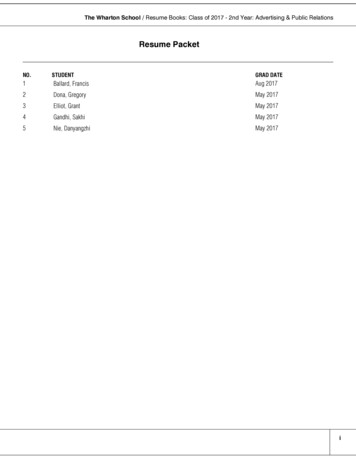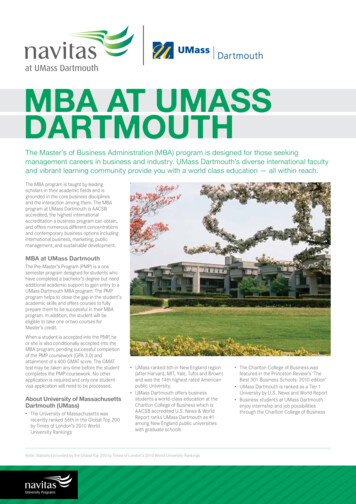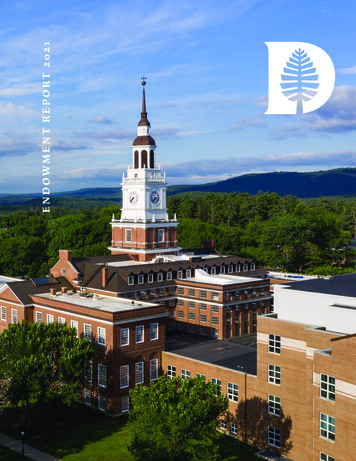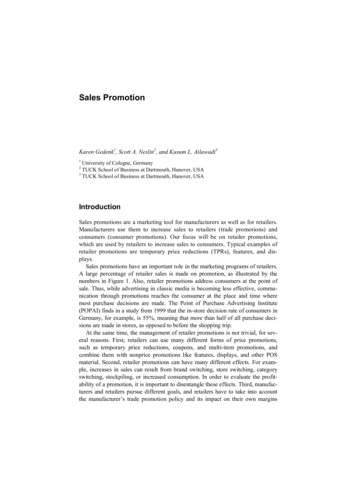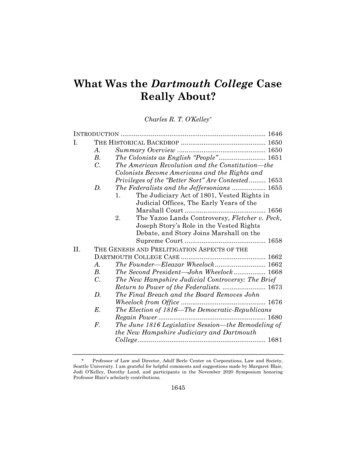
Transcription
What Was the Dartmouth College CaseReally About?Charles R. T. O’Kelley *INTRODUCTION . 1646I.THE HISTORICAL BACKDROP . 1650A.Summary Overview . 1650B.The Colonists as English “People” . 1651C.The American Revolution and the Constitution—theColonists Become Americans and the Rights andPrivileges of the “Better Sort” Are Contested . 1653D.The Federalists and the Jeffersonians . 16551.The Judiciary Act of 1801, Vested Rights inJudicial Offices, The Early Years of theMarshall Court . 16562.The Yazoo Lands Controversy, Fletcher v. Peck,Joseph Story’s Role in the Vested RightsDebate, and Story Joins Marshall on theSupreme Court . 1658II.THE GENESIS AND PRELITIGATION ASPECTS OF THEDARTMOUTH COLLEGE CASE . 1662A.The Founder—Eleazar Wheelock . 1662B.The Second President—John Wheelock . 1668C.The New Hampshire Judicial Controversy: The BriefReturn to Power of the Federalists. . 1673D.The Final Breach and the Board Removes JohnWheelock from Office . 1676E.The Election of 1816—The Democratic-RepublicansRegain Power . 1680F.The June 1816 Legislative Session—the Remodeling ofthe New Hampshire Judiciary and DartmouthCollege . 1681*Professor of Law and Director, Adolf Berle Center on Corporations, Law and Society,Seattle University. I am grateful for helpful comments and suggestions made by Margaret Blair,Judi O’Kelley, Dorothy Lund, and participants in the November 2020 Symposium honoringProfessor Blair’s scholarly contributions.1645
1646VANDERBILT LAW REVIEW[Vol. 74:6:16251.2.Remodeling the Judiciary. 1681“Amending” the Dartmouth College Charter. 1683G.The Post-Legislative Session Intrigue—Compromise,Submit, or Fight? . 1685III.THE LITIGATION IN THE NEW HAMPSHIRE COURTS . 1694A.Preliminaries—The Issue Is Joined . 1694B.Exeter—The Arguments Before the New HampshireSuperior Court of Judiciary . 16951.The Setting . 16952.Woodward’s Advocates . 16963.The College Advocates . 16964.The Superior Court of Judicature and ChiefJustice Richardson . 16975.The Nature of the Arguments Presented . 1698C.The Richardson Opinion. 1699IV.THE END GAME—THE UNITED STATES SUPREME COURT . 1703A.On to Washington . 1703B.The Supreme Court Arguments . 17061.The Proceedings on March 10–12, 1818 . 17062.The Source of Webster’s SubstantiveArguments . 1707C.From the Supreme Court Argument to theDecision . 1710D.The Supreme Court Opinions . 17131.The Contract Clause Issue . 17132.Justice Story’s Opinion. 1715a.Story’s Intellectual Passions. 1715b.Adopting and Transforming EnglishPrecedents . 1715c.The Business Corporation andthe State . 1717d.Vested Rights in Judicial Office . 17193.Chief Justice Marshall’s Opinion . 1719CONCLUSION . 1722INTRODUCTIONIn 1769, King George III issued a Royal Charter incorporatingtwelve persons as The Trustees of Dartmouth College with the right ofself-perpetuation. The charter also identified one of the trustees,Eleazar Wheelock, as the founder and initial president of the
2021]WHAT WAS THE DARTMOUTH COLLEGECASE REALLY ABOUT?1647corporation, with the right by provision in his last will and testamentto appoint his successor in office. The purpose of the grant was toestablish a college in New Hampshire, and this was done in the fall of1770. Shortly before his death in 1779, Eleazar provided in his will thathis son John, then away fighting in the American Revolution, would behis successor as president. John accepted the office, and was thedominant force in the affairs of Dartmouth College until a falling outwith the board of trustees led to his removal from office in 1815. John’sefforts to regain office led the New Hampshire legislature to amend theCharter of 1769, authorizing a new board, whose trustees thenreappointed John to the presidency. The old trustees refused to acceptthe legitimacy of the new board, and Dartmouth College split intowarring camps, each purporting to be the legitimate corporation, andeach with its own body of students and faculty. The old trustees filedsuit seeking to invalidate the New Hampshire legislation. On February2, 1819, fifty years after the issuance of the charter, John Marshall readin open court his famous opinion in the Dartmouth College case,Trustees of Dartmouth College v. Woodward, holding that theNew Hampshire legislation violated the Contract Clause ofthe Constitution. 1This Article is the first modern work of corporation lawscholarship fully examining the Dartmouth College case as it was livedand understood at the time. Earlier scholars, the author of this Articleincluded, 2 have relied on the case to make doctrinal and theory-of-thefirm arguments about Supreme Court precedents regarding theconstitutional rights of corporations. Moreover, these earlier workshave primarily focused on, and found talismanic meaning, in twosentences in Marshall’s opinion:A corporation is an artificial being, invisible, intangible, and existing only incontemplation of law. Being the mere creature of law, it possesses only those propertieswhich the charter of its creation confers upon it, either expressly, or as incidental to itsvery existence. 3With this prior focus, corporate law scholars typically haveviewed the importance of the Dartmouth College case as early evidenceof what the founders and the jurists in that case might have thought1.17 U.S. (4 Wheat.) 518, 665 (1819).2.See Charles R. T. O’Kelley, The Constitutional Rights of Corporations Revisited: Socialand Political Expression and the Corporation after First National Bank of Boston v. Bellotti, 67GEO. L.J. 1347 (1979) (discussing the difficulty in applying familiar constitutional principles tocorporations, and analyzing the underlying conceptual doctrines that have guided the Court in itsprevious decisions).3.Dartmouth Coll., 17 U.S. (4 Wheat.) at 636.
1648VANDERBILT LAW REVIEW[Vol. 74:6:1625had they been presented with a question concerning a corporation’sFirst Amendment rights. 4 Supreme Court Justices in modern corporatespeech cases have used Marshall’s two sentences similarly. 5The contribution and focus of this paper is understanding theDartmouth College case in a broader historical sense, as an integral partof two ongoing struggles. The first involved the contest between libertyand power that characterized the founding of America and itssubsequent evolution from a disparate collection of English colonies andEnglish colonists hewing to English norms and customs into a separatenation with a decidedly different, more egalitarian and democratic setof norms and values. The second, beginning to emerge in full force asthe Dartmouth College controversy proceeded, concerned the onset ofthe Industrial Revolution and the competing interests of thefederal government, state legislatures, individual citizens, andincorporated capital. 64.See, e.g., Naomi R. Lamoreaux & William J. Novak, An Introduction to CORPORATIONSAMERICAN DEMOCRACY 1, 3 (Naomi R. Lamoreaux & William J. Novak eds., 2017) (stating“Chief Justice John Marshall laid out the basic principle [of limited corporate rights] in the famousDartmouth College case . . . ,” and then citing the aforementioned two sentences from the opinion);Leo E. Strine, Jr. & Nicholas Walter, Originalist or Original: The Difficulties of ReconcilingCitizens United with Corporate Law History, 91 NOTRE DAME L. REV. 877, 880–81 (2016) (citingthe two sentences before stating,As an originalist matter, therefore, it was impossible for the First Amendment togenerally accord business corporations broad expressive rights because theunderstanding at the time was that corporations only had the rights specificallygranted in their charters, and that corporations were not in any way persons like actualhuman beings.5.See First Nat’l Bank of Boston v. Bellotti, 435 U.S. 765, 823–28 (1978) (Rehnquist, J.,dissenting) (citing Marshall’s two sentences as the analytical framework that the majority shouldhave used); Citizens United v. FEC, 558 U.S. 310, 428–29 (2010) (Stevens, J., concurring in part,dissenting in part) (citing Marshall’s two sentences and other sources to establish that the Framersdid not intend to extend First Amendment protections to corporations); Burwell v. Hobby LobbyStores, Inc., 573 U.S. 682, 751–52 (2014) (Ginsburg, J., dissenting) (citing the first of Marshall’stwo sentences to explain why “[u]ntil this litigation, no decision of this Court recognized a forprofit corporation’s qualification for a religious exemption from a generally applicable law, whetherunder the Free Exercise Clause or RFRA”).6.See generally STANLEY ELKINS & ERIC MCKITRICK, THE AGE OF FEDERALISM (1993). Thescholarly effort to understand what the founding generation thought and believed when declaringindependence, when adopting the Articles of Confederation, and when later adopting theConstitution has been described as “accomplished in the face of almost unimaginabledifficulty . . . represent[ing] an extraordinary effort of rescue, a retrieval of something which in thecourse of time had become all but lost.” Id. at 5. Thus, if Alexis de Tocqueville had been droppedinto the American colonies in 1765, as Eleazar Wheelock was seeking a charter for what wouldbecome Dartmouth College, or into the young American nation in 1790, or anytime in between, hisfamous book would have described an America unrecognizable as a modern democracy. In contrast,shortly before Tocqueville’s actual visit to America in 1831, “the principal components for astructure of norms and social values most appropriate to the workings of a capitalist, democratic,equalitarian culture were fully in place . . . though not very much before then . . . .” Id. Thus, theDartmouth College case, litigated between 1817 and 1819, sits at a critical juncture in the creationof modern America as “no subsequent rearrangements of value[s] or transformations in modes ofAND
2021]WHAT WAS THE DARTMOUTH COLLEGECASE REALLY ABOUT?1649Viewed through this more comprehensive lens, the DartmouthCollege case highlights key aspects of the American story: the centralityof religion and the struggle for religious tolerance; the centrality ofprivate property and the tension between majority rule and vestedproperty rights; the ongoing battle to properly define the public andprivate realms; and the simmering competition for power and authorityboth between the Supreme Court and other branches of the federalgovernment, and between the Supreme Court and state legislatures. Allof these aspects of the American story played out in the Dartmouth caseagainst the differing visions of the Federalists and the Jeffersonians,and against the backdrop of the Yazoo land controversy and the FederalJudiciary Act of 1801.Moreover, the early history of Dartmouth College provides a casestudy in the nature of wealth creation and business leadership beforeand after the Revolution. Dartmouth College was founded by EleazarWheelock, a preacher turned entrepreneur who used religion andgovernment grants to create both personal wealth and an importantinstitution. Eleazar’s successor in control of Dartmouth College—hisson John—illustrates the not-uncommon shortcomings of secondgeneration leadership; John’s missteps and personal failings alienatedhis board and key constituents. The resulting battle for control ofDartmouth College played out over nearly a decade before its resolutionby the U.S. Supreme Court.Viewed through this broader lens, previously unexaminedportions of the Dartmouth College opinions come into view, and the oftcited two sentences in Marshall’s opinion take on a new light as but partof a larger and more nuanced analytical framework in which acorporation is presumed ab initio to have the same constitutional rightsas natural persons, absent clear textual or other evidence to thecontrary. As the Article shows, what Marshall thought aboutcorporations changed dramatically as the Dartmouth College caseunfolded, as did the views of Joseph Story, writing in concurrence. WhatMarshall and Story previously thought yielded to a richerunderstanding of the corporation’s emerging role in American societyand the need to adapt the constitutional meaning of personal liberties,property rights, and constitutional interpretation accordingly.The paper proceeds as follows: Part I describes andcontextualizes the larger historical, legal, social, and cultural backdropin which the Dartmouth College controversy took place. Part II exploresthought and feeling could compare in magnitude to those that occurred in the fifteen years or soprior to 1830.” Id.
1650VANDERBILT LAW REVIEW[Vol. 74:6:1625the genesis and prelitigation aspects of the Dartmouth Collegecontroversy. Part III examines the Dartmouth College litigation in thecourts of New Hampshire. Part IV follows the case from the courts ofNew Hampshire to the ultimate decision by the U.S. Supreme Court.The conclusion follows.I. THE HISTORICAL BACKDROPA. Summary OverviewThe Dartmouth College case played out in New Hampshire, andfinally in the U.S. Supreme Court, against the backdrop of theFederalist Party’s decline in power and influence, both nationally andin New England. With Jefferson’s ascendancy in 1801, the Federalistsbecame a weak minority party nationally, and the party’s grip on NewEngland came under increasing attack by the DemocraticRepublicans. 7 The run-up to and War of 1812 brought a brief resurgencein Federalist power, but this proved a last gasp. 8 The DemocraticRepublicans’ resounding victory in the 1816 presidential andcongressional elections marked the end of the Federalists as a nationalpolitical party. It also marked for extinction the Standing Order in NewEngland—the dominant political and cultural alliance betweenCongregationalist ministers and leading citizens that traced its rootsand authority to the founding Puritans. 9The struggle between the Federalists and their opponents in theearly years of the eighteenth century was rooted in earlier strugglesbetween the colonies and England that gave rise to the AmericanRevolution. 10 And that struggle was rooted in tensions between theEnglish people and their kings that gave rise to the Magna Carta in1215, and the constantly evolving role of the common law andParliament as counterweights to the power of the Crown and as7.Phillip J. Lampi, The Federalist Party Resurgence, 1808-1816: Evidence from the NewNation Votes Database, 33 J. EARLY REPUBLIC 255, 259 (2013).8.Id. at 261–66, 280.9.See id.; DONALD B. COLE, JACKSONIAN DEMOCRACY IN NEW HAMPSHIRE: 1800-1851, at 30–31 (1970). For the origins, nature, dominance, and decline of the “Standing Order” in New England,see CHRISTOPHER GRASSO, A SPEAKING ARISTOCRACY: TRANSFORMING PUBLIC DISCOURSE INEIGHTEENTH-CENTURY CONNECTICUT (1999); RICHARD L. BUSHMAN, FROM PURITAN TO YANKEE:CHARACTER AND THE SOCIAL ORDER IN CONNECTICUT, 1690-1765 (1967); and PETER S. FIELD, THECRISIS OF THE STANDING ORDER: CLERICAL INTELLECTUALS AND CULTURAL AUTHORITY INMASSACHUSETTS, 1780-1833 (1998).10. See PAULINE MAIER, FROM RESISTANCE TO REVOLUTION: COLONIAL RADICALS AND THEDEVELOPMENT OF AMERICAN OPPOSITION TO BRITAIN, 1765-1776 (2d prtg. 1991) (detailing the rootcauses that transformed American colonists from loyal English subjects in 1765 to revolutionariesa decade later).
2021]WHAT WAS THE DARTMOUTH COLLEGECASE REALLY ABOUT?1651expressions of the rights and privileges of the English people. 11 Centralto this multicentury conflict was the evolving nature of property rights,including the rights conferred by the grant or existence of acorporate charter. 12B. The Colonists as English “People”At England’s infancy, the concept of individual rights to libertyand property was deeply iengrained in society:Englishmen valued their rights to their personal liberty and property—rights that wereembedded in their common law. The common law had deeply held principles including,for example, the notions that no one could be a judge in his own cause and that no one,not even the king, could legally take another’s property without that person’s consent.These rights and liberties belonged to all the people of England, and they adhered in eachperson as a person. Their force did not depend on their written delineation; they existedin the customary or unwritten law of England that went back to time immemorial. 13Set against this were the prerogatives of the king, whichentailed both the absolute right to govern and the correspondingresponsibility to safeguard the English people. 14 It was the king’spersistent infringement on the people’s liberties that gave rise toperiodic efforts to obtain the king’s written acknowledgment of a rightin question, which “in the early middle ages took the form of coronationoaths and assizes and charters issued by the crown.” 15 This ongoingstruggle ultimately led to the Glorious Revolution and in 1689 to theEnglish Bill of Rights, whereby the king conceded importantgovernance rights and powers to Parliament. 1611. Gordon Wood, The Origins of Vested Rights in the Early Republic, 85 VA. L. REV. 1421,1422–25 (1999); P.B. Waite, The Struggle of Prerogative and Common Law in the Reign of JamesI, 25 CANADIAN J. ECON. & POL. SCI. 144 (1959).12. See, e.g., Catherine Patterson, Quo Warranto and Borough Corporations in Early StuartEngland: Royal Prerogative and Local Privileges in the Central Courts, 120 ENG. HIST. REV. 879(2005) (discussing the use of quo warranto in the first half of the seventeenth century as a tool bywhich the Crown controlled corporations); Robert H. George, The Charters Granted to EnglishParliamentary Corporations in 1688, 55 ENG. HIST. REV. 47 (1940) (discussing the substantialchanges that occurred during King James II’s reign and “attack” on English parliamentarycorporations).13. Wood, supra note 11, at 1423.14. See id. at 1424:[T]he king had his right to govern, and the people had their equally ancient and equallylegitimate rights to their liberties and their property. Indeed, it is perhaps not too muchto say that the whole of English constitutional history can be seen as a struggle betweenthese two competing sets of rights.15. Id.16. Id. at 1425.
1652VANDERBILT LAW REVIEW[Vol. 74:6:1625Of critical importance is the English people’s understanding oftheir Bill of Rights as the American Revolution approached:So convinced were Englishmen in the decades following 1689 that tyranny could comeonly from a single ruler that they could hardly conceive of the people tyrannizingthemselves. Once Parliament became sovereign, once the body that represented and spokefor them—the House of Commons—had gained control of the crown authority that hadtraditionally threatened their liberties, the English people lost much of their formerinterest in codifying and listing their personal rights. Charters defining the people’s rightsand contracts between the people and government no longer made sense if the governmentwas controlled by the people themselves. . . . By the time of the American Revolution,therefore, most educated Englishmen had become convinced that their rights existed onlyagainst the crown. Against their representative and sovereign Parliament, which was theguardian of these rights, they existed not at all. 17Importantly, the Glorious Revolution and the English Bill ofRights did not change the hierarchical nature of English society.English people of all sorts understood that the Revolution and itsbenefits skewed heavily in favor of landholders and what in Americawould be seen as “the better sort.” 18 Thus, the rights of the English“people” were primarily the rights of landholding men, and those rightsrespected and reinforced the social hierarchy. 19In the decade immediately preceding the American Revolution,Parliament with the king’s support rolled out a series of acts that acritical mass of colonists viewed as violations of their rights asEnglishmen. 20 Infringement of rights granted via corporate charters—returning to the repugnant actions that had marked the reigns of JamesI and James II—were central to the growing view. 21 Colonists saw theircorporate rights as especially vulnerable in light of Parliament’sdisregard for the charters of the City of London, the Massachusetts Baycolony, the province of Quebec, and the colony of Grenada. 22 Thisconcern heightened when Parliament enacted the East India CompanyAct of 1773, imposing fundamental changes on the corporation that boreits name. 23 The colonists’ worst fears came to pass with the passage ofthe Massachusetts Government Act of 1774, which amended theMassachusetts Charter of 1691 to severely curtail colonists’ self-17. Id. at 1425–26.18. 1 HARRY L. WATSON, BUILDING THE AMERICAN REPUBLIC: A NARRATIVE HISTORY TO 1877,at 140 (2018).19. Id. at 139–40, 164–68.20. The initial flurry of parliamentary actions included the Stamp Act of 1765, the QuarteringAct of 1865, the New York Restraining Act of 1767, and the Townsend Revenue Act of 1767. MAIER,supra note 10, at 51–60, 113–16, 145–49.21. See id. at 186 (“Now charters seemed no more respected by British authorities than therest of the law.”).22. Id. at 183–87.23. Id. at 187.
2021]WHAT WAS THE DARTMOUTH COLLEGECASE REALLY ABOUT?1653governance rights. 24 Parliament’s repeated assaults on corporatecharter rights, and the king’s disdain for the colonists’ pleas for hisintervention, were a significant factor in pushing the colonists to thepoint of open rebellion. 25C. The American Revolution and the Constitution—the ColonistsBecome Americans and the Rights and Privileges of the “Better Sort”Are ContestedIn the conduct and immediate aftermath of the AmericanRevolution, the relationship between the individual and the state, andthe nature of individual liberties and property rights, faced anAmerican reconceptualization of the English constitutional system.Before the Revolution, rights and obligations were viewed as a contractbetween two equals—Parliament (as representative of the people) andthe king—and there was little distinction perceived between public andprivate spheres:[E]ven as late as the eve of the Revolution the modern distinction between public andprivate was still not clear. The people’s ancient rights and liberties were as much publicas private, just as the king’s rights—his prerogatives—were as much private as they werepublic. So-called public institutions had private rights and private persons had publicobligations. 26Moreover, the obligations of public service corresponded withone’s place in the social hierarchy in which landowning was a dominantfactor. Public office, including military service, was uncompensated,and the ranks were filled hierarchically, with the king at the top asEngland’s largest landowner. 27Before the Revolution, the hierarchical rights of the “better sort”were similarly entrenched in the American colonies, and once called orelected to service in a particular post, there was a strong expectation ofpermanent tenure, akin to vested rights in property. 2824. Id. at 218.25. Id. at 186–87, 225.26. Wood, supra note 11, at 1429.27. See id. at 1429–30:Indeed, everyone in the society had an obligation to help govern the realmcommensurate with his social rank—the king’s being the greatest because he stood atthe top of the social hierarchy. Thus important offices were supposed to be held only bythose who were already worthy and had already achieved economic and socialsuperiority. Just as gentlemen were expected to staff the officers’ corps of the army, sowere independent and wealthy gentlemen of leisure and education expected to supplyleadership for government.28. See BUSHMAN, supra note 9, at 268 (“The assumption had always been that ‘Gentlemenof approved Capacity and Fidelity’ were to remain in office, however unpopular their actions, so
1654VANDERBILT LAW REVIEW[Vol. 74:6:1625The Revolution destroyed the contractual and hierarchicalunderpinnings of American colonial society. Gone was the automaticrespect and right to govern to which the better sort felt entitled.Moreover, there was nothing resembling a king for the assemblage offormer colonies; instead the common interests of the newly independentstates were entrusted to a joint-venture-like confederacy of limitedscope and power. Within each newly independent state, the legislaturesassumed the power and authority of the English Parliament uncheckedby a king, and also unburdened by Parliament’s perceived role asdefender of the people against the predations of a wayward king. In aword, each state fashioned itself a republic, and the ascendancy topolitical power of “middling men” and men of the lower classes put indoubt the governance and property rights of the “better sort” who haddominated colonial life before the Revolution. 29Unchecked by a king, colonial and then state legislaturesshowed little restraint in confiscating the property of British loyalists 30and, during the Confederacy, passing laws abridging the propertyrights of creditors. 31 Concern that unbridled state legislative authoritythreatened the liberties and property rights of the better sort was oneof the main reasons that the young nation, led by those who laterbecame predominantly identified as Federalists, jettisoned the Articlesof Confederation, replaced it with the Constitution, and includedtherein the Contract Clause. 32While concern for untrammeled state legislative power was aclear impetus in the creation of the new Constitution, the desire totemper state legislative power was balanced by fear of creating a centralgovernment that would fall prey to the perceived failings of the Englishsystem that had led to the Revolution; this fear fueled the separation oflong as their character was unimpeached.”); 1 WATSON, supra note 18, at 253 (“Colonial gentlemenhad assumed that most voters would defer to men of wealth, education, and social distinction.”).29. Wood, supra note 11, at 1432–35; 1 WATSON, supra note 18, at 230. The naturalsubmission to the rule by the “better sort” before the Revolution was visceral and widespread, asrecounted by Reverend Devereux Jarrett, the son of a carpenter, in his autobiography. 1 WATSON,supra note 18, at 199–200:[W]e were accustomed to look upon, what were called gentle folks, as beings of a superiororder. . . . A periwig, in those days, was a distinguishing badge of gentle folk—and whenI saw a man riding the road, near our house, with a wig on, it would so alarm my fears,and give me such a disagreeable feeling, that I dare say, I would run off, as if for mylife. Such ideas of the difference between gentle and simple, were, I believe, universalamong all of my rank and age.30. 1 WATSON, supra note 18, at 184, 216; Brett Palfreyman, The Loyalists and the FederalConstitution: The Origins of the Bill of Attainder Clause, 35 J. EARLY REPUBLIC 451, 452–53 (2015);ELKINS & MCKITRICK, supra note 6, at 10.31. 1 WATSON, supra note 18, at 216–18.32. Wood, supra note 11, at 1434–35.
2021]WHAT WAS THE DARTMOUTH COLLEGECASE REALLY ABOUT?1655federal-government power into legislative, executive, and judicialbranches, so that neither the federal government as a whole, nor any ofits constituent parts, would be a new source of tyranny and invasion ofindividual liberties and property rights. 33D. The Federalists and the JeffersoniansDuring the Washington and Adams Administrations, concernthat the federal government would be a new source of tyranny competedwith fears that unchecked democracy would lead to destruction of theyoung nation. The Revolution and its aftermath had engaged andempowered ordinary citizens, and they did not want to go back to thedays in which they lived in awe of, and in submission to, the “bettersort.” 34 On the other hand, the Federalists, under a facially neutralWashington and the clearly Federalist Adams, viewed politicalassociations and democratic participation of ordinary citizens withgreat suspicion, and this fear increased as the French Revolution movedquickly from a seeming affirmation of the ideals of the Americanrepublic to chaos and the slaughter of political opponents. 35 But theactions taken to thwart perceived risks of sedition caused a popular fearthat the Federalists were intent on recreating the old hierarchical,perhaps even monarchical system. 36 Jefferson’s election signaled aresounding rejection of the Federalists, who would never again hold thepresidency or a majority in either house of Congress. 37The Federalists, however, remained in control of the SupremeCourt. 38 From this bastion, they would strongly influence thedevelopment of American society and provide a counterbalance to theDemocratic-Republicans. 39 Among the important questions which the33. 1 WATSON, supra no
4.See, e.g., Naomi R. Lamoreaux & William J. Novak, An Introductionto C ORPORATIONS AND AMERICAN DEMOCRACY 1, 3 (Naomi R. Lamoreaux & William J. Novak eds., 2017) (stating "Chief Justice John Marshall laid out the basic principle [of limited corporate rights] in the famous Dartmouth College case . . . ," and then citing the aforementioned two sentences from the opini on);




